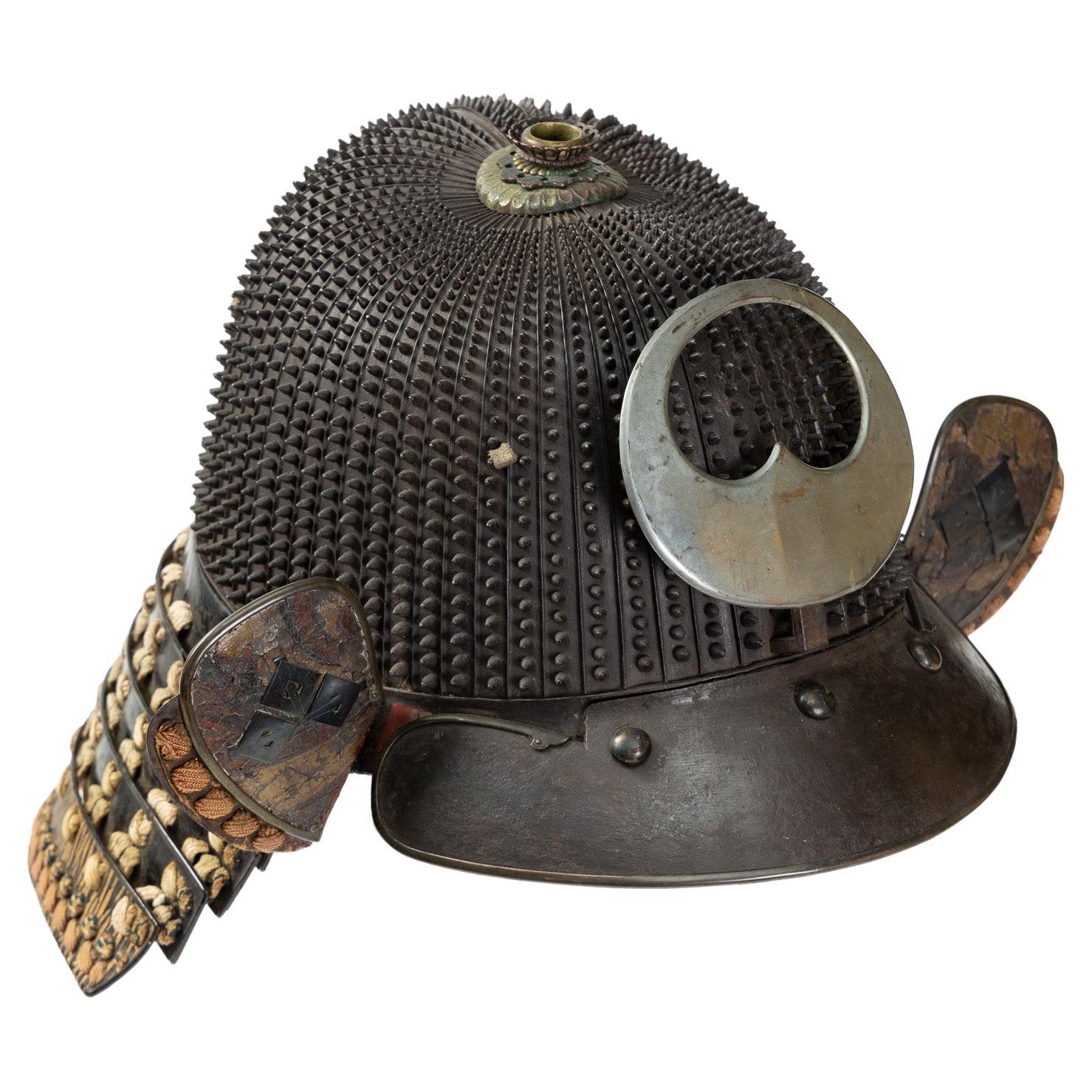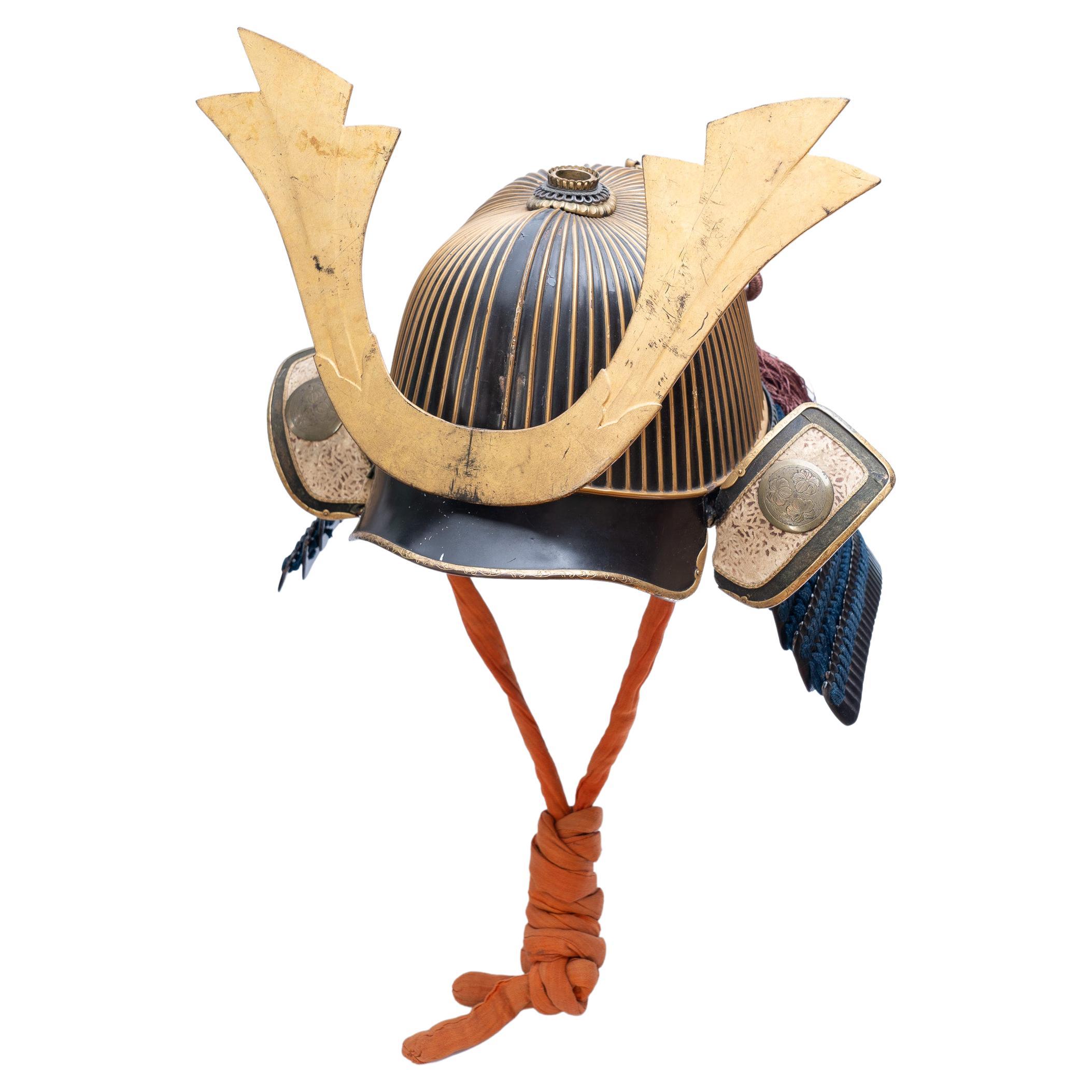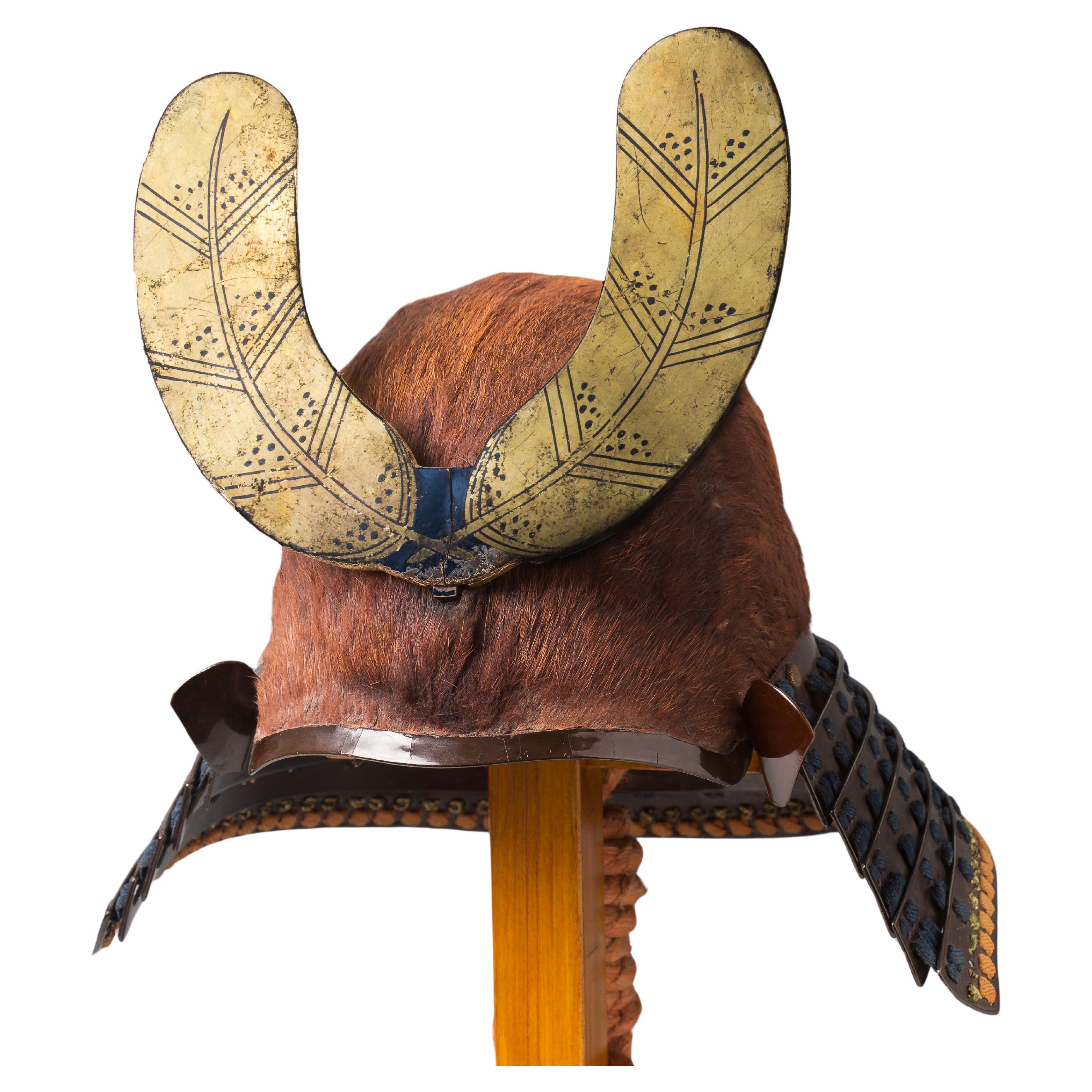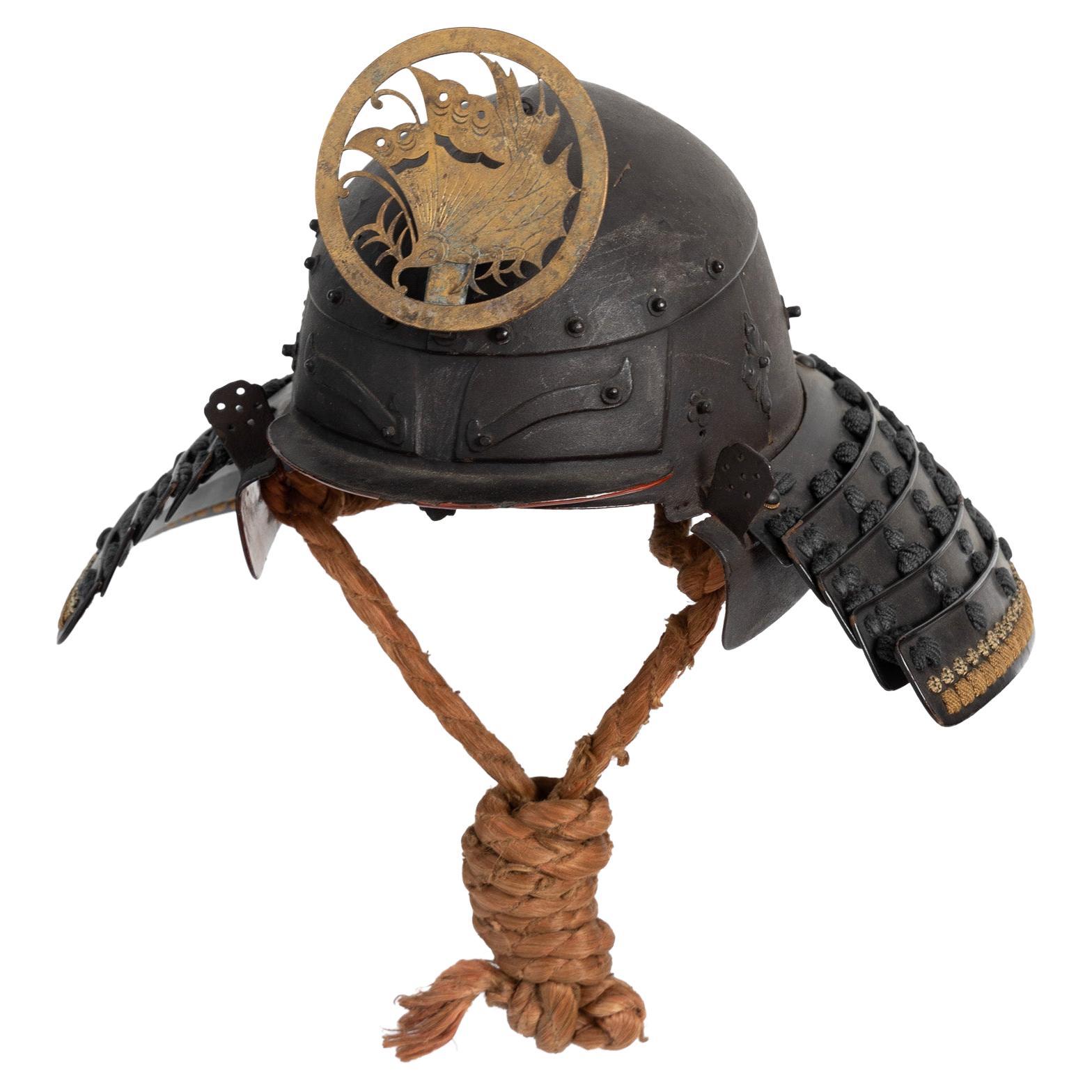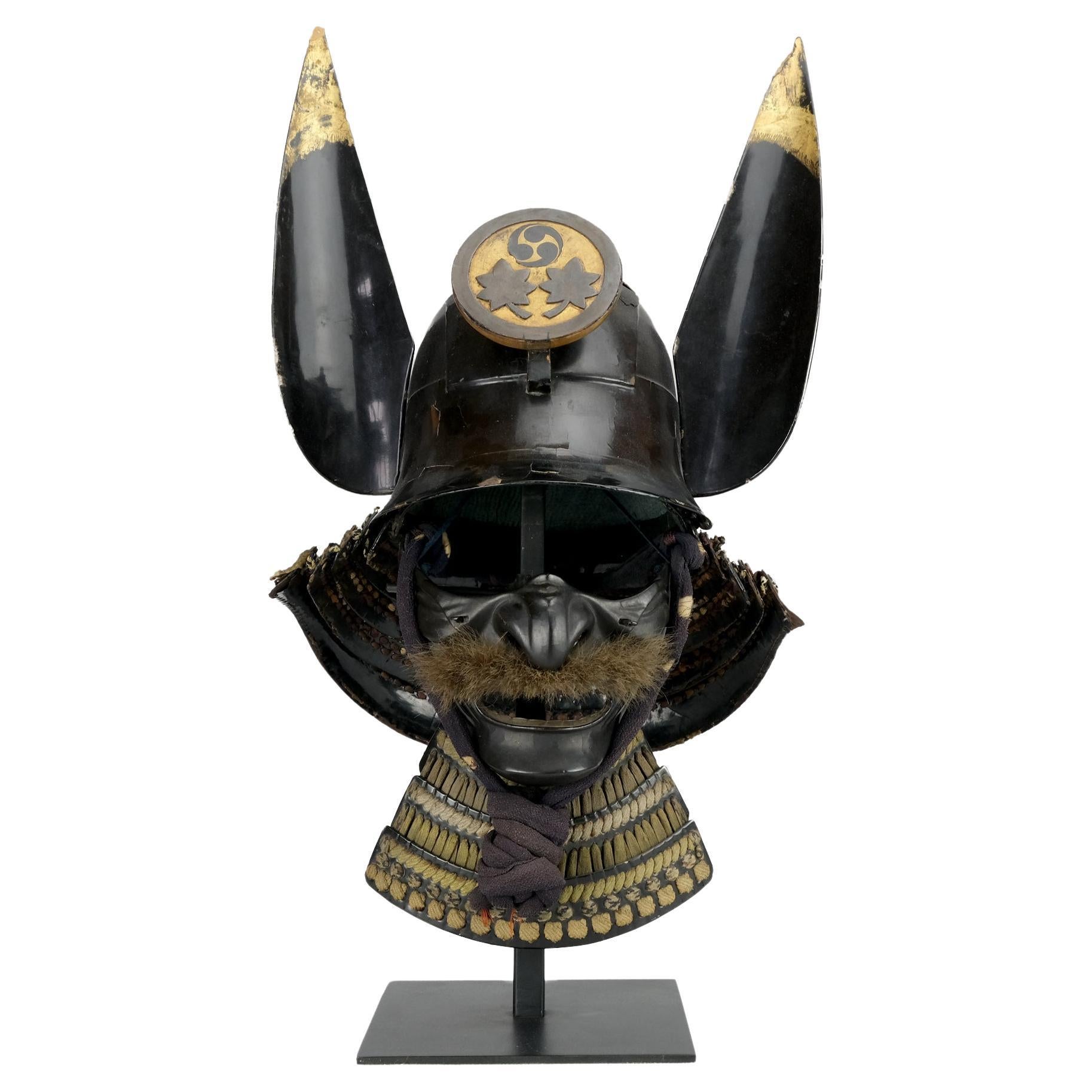Items Similar to Tōkanmuri Kabuto Samurai Helmet in the Shape of a Court CAP
Want more images or videos?
Request additional images or videos from the seller
1 of 7
Tōkanmuri Kabuto Samurai Helmet in the Shape of a Court CAP
About the Item
Tokanmuri kabuto
Samurai helmet in the shape of a court cap
Momoyama to early Edo Period
17th century
The wearing of helmets that reproduced the shapes of traditional headgear became common among members of the military class by the end of the 16th century, in part due to new battle tactics that prioritised fire-weapons and removed generals from the battlefield, in part for the new taste of the warrior class, which tended to emphasise the individuality of the commanders. Helmets shaped as a tokanmuri, a ceremonial lacquer hat worn at the Chinese court by high-ranking literati and statesmen, were undoubtedly the most successful among the broad category of kawari kabuto, or helmets
of “exceptional” shape, which became popular throughout the “Warring States period” (Sengoku Jidai). There are several variations on the theme. This one, which is particularly attractive, has an elongated shape of the bowl, which is an eight- plate toppai-bachi, and very long wakidate (side ornaments), which would actually resemble the wing-like flaps on the back of the court’s cap. The helmet’s surface is marked by geometrical lines on the lacquer, while a pair of large, stylised eyebrows decorate the front, as typical of the kabuto from the early 17th century.
- Dimensions:Height: 19.69 in (50 cm)Width: 31.5 in (80 cm)Depth: 17.72 in (45 cm)
- Materials and Techniques:
- Place of Origin:
- Period:
- Date of Manufacture:1650 circa
- Condition:
- Seller Location:Milano, IT
- Reference Number:1stDibs: LU4250234252772
About the Seller
5.0
Recognized Seller
These prestigious sellers are industry leaders and represent the highest echelon for item quality and design.
Established in 2005
1stDibs seller since 2018
10 sales on 1stDibs
Typical response time: 2 hours
- ShippingRetrieving quote...Ships From: Milano, Italy
- Return PolicyA return for this item may be initiated within 7 days of delivery.
More From This SellerView All
- Koboshi Kabuto, Samurai Helmet with Standing Rivets Haruta SchoolLocated in Milano, ITKoboshi kabuto Samurai helmet with standing rivets Haruta School Early Edo Period, 17th century A 62-plate koboshi-bachi [helmet bowl with small s...Category
Antique 17th Century Japanese Arms, Armor and Weapons
MaterialsIron
- Sujibachi kabuto 62-plate samurai helmet Haruta school, Edo periodLocated in Milano, ITSujibachi kabuto 62-plate samurai helmet Haruta school, Edo period 17th-18th century A lamellar helmet consisting of sixty-two plates joined with five rows of rivets. The surface is...Category
Antique Mid-17th Century Japanese Metalwork
MaterialsIron
- Sogonari Kabuto Samurai Helmet Shaped as a Human Head Early Edo PeriodLocated in Milano, ITSogonari Kabuto Samurai Helmet shaped as a Human Head Early Edo Period (1615 - 1867). Three-plates kawari kabuto covered with tawny hair to ...Category
Antique Early 1700s Metalwork
MaterialsFur
- Okitenugui Kabuto Samurai Helmet Shaped as a Head Towel Saika, Early Edo PeriodLocated in Milano, ITOkitenugui kabuto Samurai helmet shaped as a head towel Saika, early Edo period, 17th century The Haruta armorers who moved to Kii province in the early 17th century, took the name from the village where they worked, Saika, near Wakayama, possibly on request of the local daimyo, Asano Yukinaga, a great armour amateur. Specialised in the construction of plate helmets, they produced mainly two typologies of kabuto: one with six plates covered with a chrysanthemum-shaped plate on top and one shaped as a “head towel”, called okitenugui. The latter type of kabuto employs very heavy plates crafted in a curved manner and was improved in order to make it resistant to firearms. This okitenugui kabuto features some distinctive decorations of the Haruta school, including the application of cut-out iron elements, including eyebrows, washers and lozenge-shaped decorations on the sides. The ring on the top, however, is a rare feature and could be used to hold a small war flag.Category
Antique 17th Century Metalwork
MaterialsIron
- Suji-bachi kabuto and menpo Signed by Myōchin Muneaki and dated 1853Located in Milano, ITSuji-bachi kabuto and menpo Signed by Myōchin Muneaki and dated 1853 Signature: Kaei 6 - Ushidoshi Oshu Nihonmatsu-ju Myōchin Ki (no) Muneaki saku Made in 1853 by Myōchin Ki Muneak...Category
Antique 18th Century and Earlier Metalwork
MaterialsIron
- Samurai Mask with a Fierce Expression Ressei MenpoLocated in Milano, ITSamurai mask with a fierce expression Ressei Menpo DATE Edo period (1615 - 1867), 18th century A red lacquered high-level mask, with fierce (res...Category
Antique 18th Century Japanese Metalwork
MaterialsIron
You May Also Like
- Japanese Samurai Helmet Kabuto Edo Period (1603-1867)Located in Hampstead, QCA Japanese Samurai black-lacquered helmet (kabuto) in suji bachi style and of a goshozan shape consisting of the: - main dome (hachi) made from 16 plates in natural iron riveted to...Category
Antique Early 19th Century Japanese Edo Metalwork
MaterialsIron
- Samurai Helmet "Zunari Kabuto" - Early Edo (circa 1610)Located in Paris, FRSamurai Helmet "Zunari kabuto" with 3 black lacquered iron plates. Japan, early EDO period, circa 1610. Neck protector (shikoro), 5-strip hineno, laced brown, beige and green. Central ornament (maedate) in gold and silver lacquered wood. Triple tomo with 2 maple leaves. 2 rounded horn-shaped side ornaments (wakidate) in black and gold lacquered wood. Black-lacquered iron mask...Category
Antique Early 17th Century Japanese Edo Antiquities
MaterialsIron
- Bronze Koro 'Japanese Incense Burner' in the Shape of a RoosterLocated in Hudson, NYBronze Koro (Japanese incense burner) in the shape of a rooster Removable top.Category
Antique Early 19th Century Japanese Metalwork
MaterialsBronze
- Japanese Bronze Koro ‘Incense Burner’ in the Shape of a TurkeyLocated in Hudson, NYMeiji period (1868-1912) bronze, with removable top, stylized geometric shape and silver inlay. Signature reads: Miharu Kadayashi.Category
Early 20th Century Japanese Meiji Metalwork
MaterialsSilver, Bronze
- Hanging Mughal Deccani Bronze Oil Lamp in the Shape of a Bird IndiaLocated in North Hollywood, CAAntique hanging cast bronze oil lamp in the shape of a beautiful mythical bird peacock figure with hanger chain. The body of the bird acts as a reservoi...Category
Antique Late 19th Century Indian Agra Metalwork
MaterialsBronze
- Pair of Japanese Abumi Samurai Stirrups with Dragons, c. 1800Located in Chicago, ILInlaid with brass and silver, this extraordinary pair of Japanese bronze stirrups, known as Abumi, were crafted in the Edo period (1603-1868) for use on a Samurai's horse. Each is wo...Category
Antique Early 19th Century Japanese Edo Metalwork
MaterialsSilver, Bronze, Iron
Recently Viewed
View AllMore Ways To Browse
Hat Warrior
Cast Iron Japanese Tea Kettles
Antique Cast Iron Water Kettle
Cloisonne Fish Bowl
Japanese Chocolate Set Antique
Antique Sprinkler Bottles
Champleve Censer
Tiffany China Bowl
Yemeni Jambiya
Antique Japanese Saki
Chinese Dragon Costume
Vintage Arabic Coffee Pot
Antique Indian Spice Tin
Brass Rose Water Sprinkler
Chinese Copper Teapot
India 19th Century Hand Etched Brass Vase
Japanese Belt Buckle
Kulah Khud

